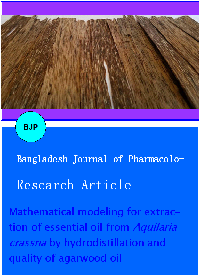Mathematical modeling for extraction of essential oil from Aquilaria crassna by hydrodistillation and quality of agarwood oil
DOI:
https://doi.org/10.3329/bjp.v6i1.7902Keywords:
Agarwood, Aquilaria crassna, Essential oil, Kinetics, GC-MS, Refractive indexAbstract
Agarwood oil is widely used in medicine, perfume and cosmetic industries due to its unique properties and high medicinal value. However, knowledge on distillation process and standard for quality of the oil are far from sufficient. In this work, agarwood oil was hydrodistilled at various temperatures in order to study the distillation kinetics and quality of the oil. Higher oil yield and better quality of the oil were obtained at higher operating temperature. The mechanism of oil hydrodistillation consisted of two stages: washing stage and diffusion stage. The diffusion stage was the controlling step of oil hydrodistillation. Both mass transfer kinetic coefficients increased with increasing distillation temperatures. The oil gain at a higher temperature had a darker color and seemed to stick longer to the human skin. The different physical properties of the oil were a result of different chemical constituents exhibited in GC-MS profiles.
Downloads
3887
4938 Read
1111
References
Abdullah A, Ismail NKN, Kadir TAA, Zain JM, Jusoh NA, Ali NM. Agar wood grade determination system using image processing technique. Proceedings of the International Conference on Electrical Engineering and Informatics, Institut Teknologi, Bandung, Indonesia. June 17-19, 2007, pp 427-29.
Adam RP. Identification of essential oil components by gas chromatography/quadrupole mass spectroscopy. 3rd ed. Allured Publishing, Carol Stream, IL. 2001, p 456.
Barden A, Anak NA, Mulliken T, Song M. Hearth of the Matter: Agarwood use and trade and CITES implementation for Aquilaria malaccensis, Traffic Network Report 19982000. TRAFFIC International, Cambridge, UK, 2000, pp 1-51.
Bhuiyan MNI, Begum J, Bhuiyan MNH. Analysis of essential oil of eaglewood tree (Aqulilaria agallocha Roxb.) by gas chromatography mass spectrometry. Bangladesh J Pharmacol. 2009; 4: 24-28.
Cassel E, Vargas RMF, Martinez N, Lorenzo D, Dellacessa E. Steam distillation modeling for essential oil extraction process. Ind Crop Prod. 2009; 29: 171-76.
Hidayat W, Shakaff AYM, Ahmad MN, Adom AH. Classification of agarwood oil using an electronic nose. Sensors 2010; 10: 4675-85.
ISO 279. Essential oils: Determination of relative density at 20°C- reference method. 2nd ed. International Organization for Standardization, Geneva, 1998.
ISO 280. Essential oils: Determination of refractive index. 2nd ed. International Organization for Standardization, Geneva, 1998.
Keller PE. Mimicking biology: Applications of cognitive systems to electronic noses. Proceedings of IEEE International Symposium on Intelligent Control/Intelligent Systems and Semiotics. Cambridge, MA, USA, 1999, pp 446-51.
Koul VK, Gandotra BM, Koul S, Ghosh S, Tikoo CL, Gupta AK. Steam distillation of lemon grass (Cymbopogon spp.). Indian J Chem Technol. 2004; 11: 135-39.
Liu J, Wu J, Zhao YX, Deng YY, Mei WL, Dai HF. A new cytotoxic 2-(2-phenylethyl)chromone from Chinese eaglewood. Chin Chem Lett. 2008; 19: 934-36.
Mani S, Jaya S, Vadivambal R. Optimization of solvent extraction of Moringa (Moringa oleifera) seed kernel oil using response surface methodology. Food Bioprod Process. 2007; 85: 328-35.
Mei W-L, Zeng Y-B, Wu J, Cui H-B, Dai H-F. Chemical composition and anti-MRSA activity of the essential oil from Chinese eaglewood. J Chin Pharma Sci. 2008; 17: 225-29.
Milojevi? S, Stojanovi? TD, Pali? R, Lazi? ML, Veljkovi? VB. Kinetic of distillation of essential oil from comminuted ripe juniper (Juniperus communis L.) berries. Biochem Eng. 2008; 39: 547-53.
Naef R. The volatile and semi-volatile constituents of agarwood, the infected heartwood of Aquilaria species: A review. Flavour Frag J. 2011; 26: 73-98.
Okugawa H, Ueda R, Matsumoto K, Kawanishi K, Kato A. Effect of jinkoh-eremol and agarospirol from agarwood on the central nervous system in mice. Planta Med. 1996; 62: 2-6.
Pojanagaroon S, Kaewrak C. Mechanical methods to stimulate aloes wood formation in Aquilaria crassna Pierre ex H.Lec. (kritsana) trees. Acta Hortic. 2005; 676: 161-66.
Sovová H, Aleksovski SA. Mathematical model for hydrodistillation of essential oils. Flavour Fragrance J. 2006; 21; 881-89.
Takemoto H, Yagura T, Ito M. Evaluation of volatile components from spikenard: Valerena-4,7(11)-diene is a highly active sedative compound. J Nat Med. 2009; 63: 380-85.
Treybal RE. Mass transfer operations. 3rd ed. McGraw-Hill, New York, 1975.

Additional Files
Published
How to Cite
Issue
Section
License
Authors who publish with this journal agree to the following terms:
- Authors retain copyright and grant the journal right of first publication with the work simultaneously licensed under a Creative Commons Attribution License that allows others to share the work with an acknowledgement of the work's authorship and initial publication in this journal.
- Authors are able to enter into separate, additional contractual arrangements for the non-exclusive distribution of the journal's published version of the work (e.g., post it to an institutional repository or publish it in a book), with an acknowledgement of its initial publication in this journal.
- Authors are permitted and encouraged to post their work online (e.g., in institutional repositories or on their website) prior to and during the submission process, as it can lead to productive exchanges, as well as earlier and greater citation of published work (See The Effect of Open Access).
